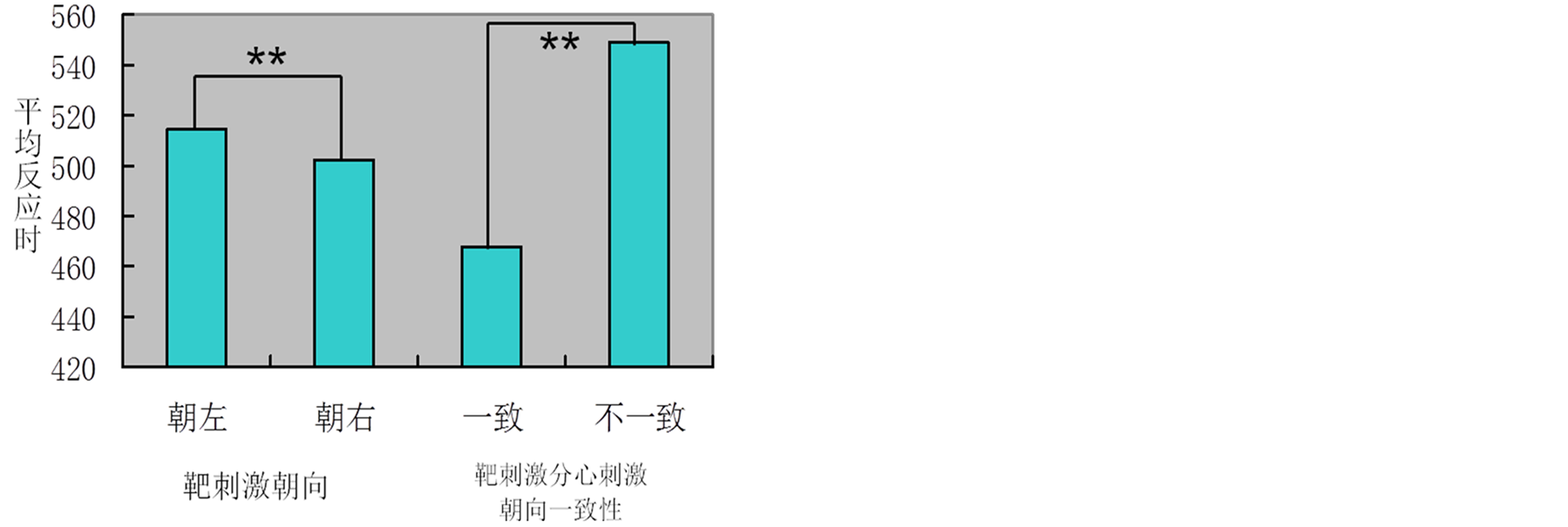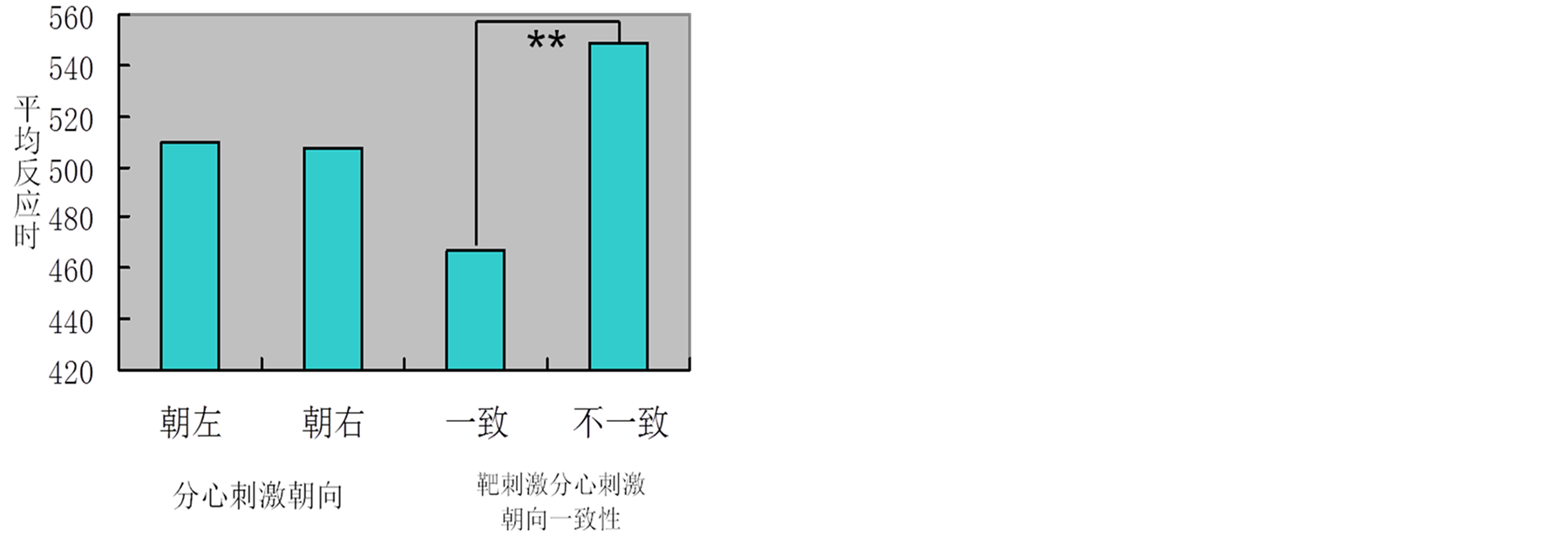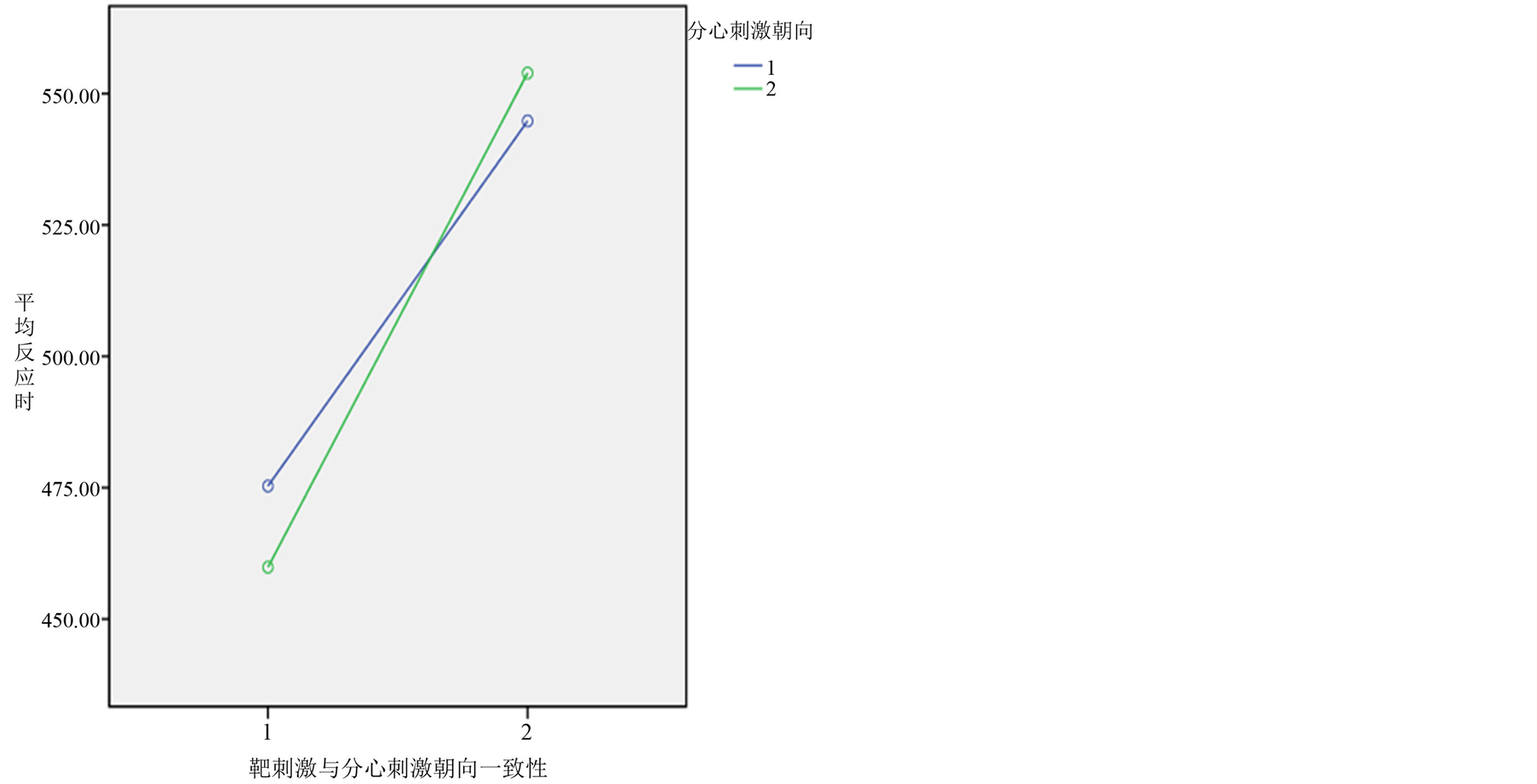Advances in Psychology
Vol.05 No.11(2015), Article ID:16455,7
pages
10.12677/AP.2015.511092
Orientation Preferences Effect in the Flanker Task
Shenli Peng, Xiao Zhang
Faculty of Psychology, Southwest University, Chongqing
Received: Nov. 5th, 2015; accepted: Nov. 24th, 2015; published: Nov. 30th, 2015
Copyright © 2015 by authors and Hans Publishers Inc.
This work is licensed under the Creative Commons Attribution International License (CC BY).
http://creativecommons.org/licenses/by/4.0/



ABSTRACT
This study explored the effects of target stimulus orientation, and consistency on orientation between target and distraction stimulus on individuals’ cognitive conflict performance through an arrow Flanker task. Repeated ANOVA and simple effect analysis on the RTs data show that: 1) when orientation of target and distraction stimulus is consistent, performance is significantly better than inconsistent condition (F(1,43) = 505.250, p < 0.001), referring to a Flanker effect; 2) when target stimulus is right-oriented, performance is significantly better than that when left- oriented (F(1,43) = 19.515, p < 0.001); 3) performances on the four different conditions are significantly differentiated to each other: RT (rrrrr) < RT (lllll)< RT (llrll)< RT (rrlrr). The present study found an orientation preference effect in Flanker task; that is to say, right-oriented stimuli induce a significantly faster response than left-oriented stimuli. Further researches will focus on exploring the underlying brain mechanism of this orientation preference, and its potential evolutionary sense.
Keywords:Flanker, Cognitive Conflict, Stimulus Features, Orientation Preference

Flanker任务中的朝向偏好效应
彭申立,张潇
西南大学心理学部,重庆

收稿日期:2015年11月5日;录用日期:2015年11月24日;发布日期:2015年11月30日

摘 要
采用经典的箭头Flanker任务考察刺激特征对于认知冲突任务成绩的影响.对实验数据进行多次重复测量方差分析与简单效应分析,结果表明:1) Flanker效应显著(p < 0.001);2) 靶刺激朝右时,认知冲突成绩显著好于朝左时(p < 0.001);3) 四种条件下的认知冲突成绩差异显著(ps < 0.001),表现为RT (rrrrr)显著优于RT (lllll)显著优于RT (llrll)显著优于RT (rrlrr)。本研究发现Flanker任务中存在基于刺激特征的朝向偏好效应:当靶刺激为朝右的箭头时,反应时显著更快。进一步的研究将探索这种朝向偏好脑神经机制,及可能具备的进化学意义。
关键词 :Flanker,认知冲突,刺激特征,朝向偏好

1. 引言
Flanker任务,又称为侧抑制任务, Eriksen等人(1974) 在探究干扰刺激对目标刺激识别的影响作用时最先采用了这一任务范式。Flanker任务中属性相近的干扰刺激与靶刺激同时呈现,要求被试在干扰刺激中识别出目标刺激,是用于研究认知冲突的经典范式之一(还包括Stroop范式和Simon范式) (胡凤培,王倩,徐莲,葛列众,2012;曲之毅,刘惠军,刘铁洋,于斌,2015) 。
Flanker效应,又称冲突效应(conflicting effect),是指Flanker任务中,靶刺激朝向的判断受到两侧分心刺激(Flankers)的影响,靶刺激与分心刺激朝向一致时,反应时快于二者不一致时 (Bugg, 2008) 。
当前针对包括Flanker范式在内的认知冲突范式的研究主要集中于冲突适应效应及其脑机制 (Egner, 2007; Notebaert & Verguts, 2011) 。冲突适应效应(conflict adaptation effect, CAE),又称Gratton效应,是指在试次序列中,被试在如果在前一个试次中经历了认知冲突,则会使其在当前试次中更好地解决冲突 (Gratton, Coles, & Donchin, 1992;刘培朵,杨文静,田夏,陈安涛,2012) 。目前对CAE及其神经机制的解释主要有冲突监测理论(conflict monitoring theory)、特征整合理论(feature integration account)和特征整合理论(feature integration account)三种理论 (Botvinick et al., 1999; Botvinick, Cohen, & Carter, 2004; Hommel, Proctor, & Vu, 2004; Verguts & Notebaert, 2009) ,在神经机制方面三种理论各有所争,但普遍认为CAE激活了脑区与冲突的监测和控制有关的扣带前回(anterior cingulate cortex, ACC)和背外侧前额叶(dorsal lateral prefrontal cortex, DLPFC) (Fischer et al., 2010; Mayr et al., 2003; Ullsperger et al., 2005; Verguts & Notebaert, 2008) 。
为更加全面地探讨Flanker任务下认知冲突效应,研究者采用各种不同类型的刺激进行实验。除 Eriksen等人(1974) 经典Flanker任务中采用的字母刺激外, Gartton等人(1992) 采用箭头作为任务刺激,也得到了显著的冲突适应效应; Fenske & Eastood (2003) 采用面部表情构成的Flanker任务获得带有情绪属性的冲突效应; Ochasner等人(2009) 采用以英文词汇为刺激的Flanker任务探讨了认知冲突和情绪冲突的对应脑机制; 曲之毅等人(2015) 以汉语词汇为材料,分析了认知和情绪冲突及其冲突适应效应; Verbruggen等人(2006) 使用彩色平行线作为任务刺激探讨了Flanker任务下的冲突效应和冲突适应效应。
采用不同的刺激材料分析Flanker任务下的冲突效应及冲突适应效应,可以帮助研究者更加全面地了解个体的冲突监测和冲突控制能力,并希望获得普遍的、共同的脑神经机制。但是,引入不同的刺激,也会导致这些刺激本身所附带的属性对我们所要研究的内容产生影响作用。如个体在涉及情绪的Flanker任务中的成绩差异可能是由于其情绪状态所造成;颜色偏好不同的个体在完成涉及颜色的Flanker任务时其结果可能受到颜色偏好的影响。本研究关注经典的箭头Flanker任务中是否同样存在类似的朝向偏好效应可能影响到任务成绩。
2. 方法
2.1. 被试
随机选取44名在校学生(男生7人),平均年龄22.04岁(SD = 1.256),年龄范围19~25岁。所有被试视力或矫正视力正常,且此前未参加过类似实验,完成实验后获得一定报酬。
2.2. 实验程序
采用经典的箭头Flanker任务程序,使用E-prime1.1软件编程。指导语呈现结束后,屏幕中央呈现一个黑色注视点“+”,500 ms后,屏幕上呈现一组箭头刺激。由五个箭头组成,中间箭头(靶刺激)的朝向可能与两侧箭头(分心刺激)朝向一致(congruent condition),也可能不一致(incongruent condition)。即箭头的组成方式一共有四种情况:靶刺激朝左,分心刺激朝左(lllll);靶刺激朝左,分心刺激朝右(rrlrr);靶刺激朝右,分心刺激朝左(llrll);靶刺激朝右,分心刺激朝右(rrrrr)。箭头刺激有可能呈现在注视点上方,也有可能呈现在注视点下方,呈现位置在组内平衡。被试需要判断靶刺激箭头的朝向:如果靶刺激朝左,被试用左手食指按F键;如果靶刺激朝右,则被试用右手食指按J键。要求被试做又快又准的反应,被试按键后刺激消失,1700 ms内未反应所有箭头消失,注视点随箭头刺激消失。
正式实验前,有12个练习试次用于被试熟悉实验流程,练习实验中每个试次结束后均有正确率和反应时的反馈,练习实验平均正确率达到0.85方可参加正式实验。正式实验共4个组,每组包含60个试次,一共240个试次。每组实验结束有该组平均正确率反馈。每组结束后被试强制休息10 s,10 s后被试可自行选择休息时间,休息好后按空格键继续下一组实验,直至整个实验结束。
2.3. 数据分析
根据正确率剔除被试,所有被试平均正确率均高于0.85,未剔除任何被试。仅对反应时数据分析,采用多重重复测量方差分析和简单效应分析。
3. 结果
如表1所示为Flanker任务中四种条件下反应时数据的描述统计结果。
3.1. 靶刺激朝向 × 靶刺激与分心刺激朝向一致性重复测量方差分析
如表2所示,靶刺激朝向(左vs.右)与靶刺激与分心刺激朝向一致性(一致vs.不一致)的2 × 2重复测量方差分析结果如下:1) 靶刺激朝向主效应显著,F(1,43) = 19.515,p < 0.001,η2 = 0.31,即靶刺激朝右时反应时显著快于朝左时;2) 靶刺激与分心刺激朝向一致性主效应显著,F(1,43) = 502.250,p < 0.001,η 2 = 0.92,即靶刺激与分心刺激朝向一致时反应时显著快于二者不一致时,表明Flanker效应显著。如图1所示,靶刺激朝向与朝向一致性的交互作用不显著。
3.2. 靶刺激与分心刺激朝向一致性 × 分心刺激朝向重复测量方差分析
如表3所示,靶刺激与分心刺激朝向一致性(一致vs.不一致)与分心刺激朝向(左vs.右)的2 × 2重复测
Table 1. Descriptive statistics of 4 conditions in Flanker (RTs)
表1. Flanker任务四种条件反应时的描述统计
Table 2. Repeated ANOVA of target stimuli orientation and consistency on orientationa
表2. 靶刺激朝向、靶刺激与分心刺激朝向一致性2 × 2重复测量方差分析结果
aDesign:Within Subjects Design:靶刺激朝向 + 一致性 + 靶刺激朝向 × 一致性;bExact statistic;cComputed using alpha = 0.05。
Table 3. Repeated ANOVA of distracting stimuli orientation and consistency on orientationa
表3. 分心刺激朝向、靶刺激与分心刺激朝向一致性2 × 2重复测量方差分析结果
aDesign:Within Subjects Design:一致性 + 分心刺激朝向 + 一致性 × 分心刺激朝向;bExact statistic;cComputed using alpha = 0.05。

Figure 1. Target stimuli orientation × consistency ANOVA
图1. 靶刺激朝向 × 一致性ANOVA
量方差分析结果如下:1) 靶刺激与分心刺激朝向一致性主效应显著,F(1,43) = 502.250,p < 0.001,η2 = 0.92,即靶刺激与分心刺激朝向一致时反应时显著快于二者不一致时,表明Flanker效应显著(如图2所示);2) 交互作用显著,F = (1,43) = 19.515,p < 0.001,η2 = 0.31,如图3所示,简单效应分析表明:四种条件下的RT均具有显著差异(ps < 0.001),表现为RT (rrrrr)显著快于RT (lllll)显著快于RT (llrll)显著快于RT (rrlrr)。分心刺激朝向主效应不显著。
4. 讨论
本研究采用经典的箭头Flanker任务探讨刺激特征本身是否会对Flanker任务下的认知冲突成绩产生影响。实验结果获得了靶刺激与分心刺激朝向一致性的显著主效应,即当中央靶刺激与两侧分心刺激的朝向一致时,其反应时显著快于靶刺激与分心刺激朝向不一致时,表明本研究获得了与前人研究结果一致的Flanker效应。当靶刺激与分心刺激属性不一致时,会产生认知冲突,被试需要耗费认知资源解决这

Figure 2. Distracting stimuli orientation × consistency ANOVA
图2. 分心刺激朝向 × 一致性ANOVA

Figure 3. Significant interaction: distracting stimuli orientation × orientation consistency
图3. 分心刺激朝向 × 刺激一致性的显著性交互作用
种冲突,因而其相较于靶刺激与分心刺激属性一致时,在反应时上表现得更差。
更令人感兴趣的是,本研究获得靶刺激朝向的显著性主效应,即不管两侧分心刺激的朝向如何,当靶刺激朝右时,其反应时成绩显著优于靶刺激朝左时。这表明,箭头Flanker任务中,箭头刺激本身的特征(朝向)对被试的认知冲突成绩会产生影响。具体来说,靶刺激朝向与靶刺激分心刺激朝向一致性的2 × 2重复测量方差分析结果表明,当中央箭头指向右方向时,被试的认知冲突成绩好于指向左方向时。由此可知,在箭头Flanker任务中,被试的判断反应时受到两个主要因素的影响:1) 靶刺激分心刺激朝向的一致性;2) 靶刺激朝向。前一个因素即Flanker效应,靶刺激与分心刺激朝向一致时,被试在判断靶刺激朝向时,即使受到两侧分心刺激的影响,但是不存在由分心刺激朝向所带来的认知冲突,因此其反应时显著更快。第二个因素则是任务中刺激特征本身的作用,即被试在对中央箭头刺激进行方向判断时,右朝向在注意和知觉上可能具备更大的优势,这种优势不仅体现在靶刺激与分心刺激朝向一致的情况下,在靶刺激与分心刺激朝向不一致的情况下,优势仍然显著存在。分心刺激朝向与靶刺激分心刺激朝向一致性的2 × 2重复测量方差分析及简单效应分析结果佐证了这一可能性,即靶刺激与分心刺激一致条件下,RT (rrrrr)显著快于RT (lllll);靶刺激与分心刺激不一致条件下,RT (llrll)显著快于RT (rrlrr)。
前人对于Flanker任务的研究主要是基于试次序列分析基础上的冲突效应及冲突适应效应分析 (Eriksen & Schultz, 1979; Davelaar & Stevens, 2009; Clayson & Larson, 2011) ,本研究首次关注Flanker任务中基于刺激本身特征所带来的朝向偏好对于任务成绩的影响。朝向信息是Flanker任务中最为常用的刺激材料之一,其对于个体认知和适应世界具有重要的作用,从进化心理学的意义上讲,朝向所表征的方位、空间等信息对于个体的生存和发展同样具有积极的意义 (周宗泽,郭永玉,杨沈龙,陈真珍,2014;Nairne et al., 2009) ,已有的部分研究发现在人类和动物中均存在朝向偏好并发现了相对应的脑区,但是针对特定的朝向所具备的注意和记忆等优势,尚无相关研究 (Blasdel, 1992; Chapman, Stryker, & Bonhoeffer, 1996; Kim & Bonhoeffer, 1994; Weliky et al., 1996) 。相较于左方向,右方向是否在注意等层面具有更大的优势,目前还没有相关研究探讨。进一步的研究将就此展开,并希望探讨这种朝向偏好的脑神经机制,及其可能具备的进化学意义。
文章引用
彭申立,张 潇. Flanker任务中的朝向偏好效应
Orientation Preferences Effect in the Flanker Task[J]. 心理学进展, 2015, 05(11): 709-715. http://dx.doi.org/10.12677/AP.2015.511092
参考文献 (References)
- 1. 胡凤培, 王倩, 徐莲, 葛列众(2012). 基于Flanker, Stroop和Simon多重冲突驱动的认知控制机制. 心理科学, 35(2), 276-281.
- 2. 刘培朵, 杨文静, 田夏, 陈安涛(2012). 冲突适应效应研究述评. 心理科学进展, 20(4), 532-541.
- 3. 曲之毅, 刘惠军, 刘铁洋, 于斌(2015). 认知和情绪词Flanker任务的冲突效应和冲突适应效应分析. 心理与行为研究, 13(3), 334-340.
- 4. 周宗泽, 郭永玉, 杨沈龙, 陈真珍(2014). 适应性记忆: 方位记忆的生存优势. 心理科学, 2, 009.
- 5. Blasdel, G. G. (1992). Orientation Selectivity, Preference, and Continuity in Monkey Striate Cortex. The Journal of Neuroscience, 12, 3139-3161.
- 6. Botvinick, M. M., Cohen, J. D., & Carter, C. S. (2004). Conflict Monitoring and Anterior Cingulate Cortex: An Update. Trends in Cognitive Sciences, 8, 539-546. http://dx.doi.org/10.1038/46035
- 7. Botvinick, M., Nystrom, L. E., Fissell, K., Carter, C. S., & Cohen, J. D. (1999). Conflict Monitoring versus Selection- for-Action in Anterior Cingulate Cortex. Nature, 402, 179-181. http://dx.doi.org/10.1016/j.tics.2004.10.003
- 8. Bugg, J. M. (2008). Opposing Influences on Conflict-Driven Adaptation in the Eriksen Flanker Task. Memory & Cognition, 36, 1217-1227. http://dx.doi.org/10.3758/MC.36.7.1217
- 9. Chapman, B., Stryker, M. P., & Bonhoeffer, T. (1996). Development of Orientation Preference Maps in Ferret Primary Visual Cortex. The Journal of Neuroscience, 16, 6443-6453.
- 10. Clayson, P. E., & Larson, M. J. (2011). Conflict Adaptation and Sequential Trial Effects: Support for the Conflict Monitoring Theory. Neuropsychologia, 49, 1953-1961. http://dx.doi.org/10.1016/j.neuropsychologia.2011.03.023
- 11. Davelaar, E. J., & Stevens, J. (2009). Sequential Dependencies in the Eriksen Flanker Task: A Direct Comparison of Two Competing Accounts. Psychonomic Bulletin & Review, 16, 121-126. http://dx.doi.org/10.3758/PBR.16.1.121
- 12. Egner, T. (2007). Congruency Sequence Effects and Cognitive Control. Cognitive, Affective, & Behavioral Neuroscience, 7, 380-390. http://dx.doi.org/10.3758/CABN.7.4.380
- 13. Eriksen, B. A., & Eriksen, C. W. (1974). Effects of Noise Letters upon the Identification of a Target Letter in a Nonsearch Task. Perception & Psychophysics, 16, 143-149. http://dx.doi.org/10.3758/BF03203267
- 14. Eriksen, C. W., & Schultz, D. W. (1979). Information Processing in Visual Search: A Continuous Flow Conception and Experimental Results. Perception & Psychophysics, 25, 249-263. http://dx.doi.org/10.3758/BF03198804
- 15. Fenske, M. J., & Eastwood, J. D. (2003). Modulation of Focused Atten-tion by Faces Expressing Emotion: Evidence from Flanker Tasks. Emotion, 3, 327-343. http://dx.doi.org/10.1037/1528-3542.3.4.327
- 16. Fischer, R., Plessow, F., Kunde, W., & Kiesel, A. (2010). Tri-al-to-Trial Modulations of the Simon Effect in Conditions of Attentional Limitations: Evidence from Dual Tasks. Journal of Experimental Psychology: Human Perception and Performance, 36, 1576-1594. http://dx.doi.org/10.1037/a0019326
- 17. Gratton, G., Coles, M. G., & Donchin, E. (1992). Optimizing the Use of Information: Strategic Control of Activation of Responses. Journal of Experimental Psychology: General, 121, 480-506. http://dx.doi.org/10.1037/0096-3445.121.4.480
- 18. Hommel, B., Proctor, R. W., & Vu, K. P. L. (2004). A Fea-ture-Integration Account of Sequential Effects in the Simon Task. Psychological Research, 68, 1-17. http://dx.doi.org/10.1007/s00426-003-0132-y
- 19. Kim, D. S., & Bonhoeffer, T. (1994). Reverse Occlusion Leads to a Precise Restoration of Orientation Preference Maps in Visual Cortex. Nature, 370, 370-372. http://dx.doi.org/10.1038/370370a0
- 20. Mayr, U., Awh, E., & Laurey, P. (2003). Conflict Adaptation Effects in the Absence of Executive Control. Nature Neuroscience, 6, 450-452. http://dx.doi.org/10.1038/nn1051
- 21. Nairne, J. S., Pandeirada, J. N., Gregory, K. J., & Van Arsdall, J. E. (2009). Adaptive Memory Fitness Relevance and the Hunt-er-Gatherer Mind. Psychological Science, 20, 740-746. http://dx.doi.org/10.1111/j.1467-9280.2009.02356.x
- 22. Notebaert, W., & Verguts, T. (2011). Conflict and Error Adaptation in the Simon Task. Acta Psychologica, 136, 212-216. http://dx.doi.org/10.1016/j.actpsy.2010.05.006
- 23. Ochsner, K. N., Hughes, B., Robertson, E. R., Cooper, J. C., & Gabrieli, J. D. (2009). Neural Systems Supporting the Control of Affective and Cognitive Conflicts. Journal of Cognitive Neuroscience, 21, 1841-1854. http://dx.doi.org/10.1162/jocn.2009.21129
- 24. Ullsperger, M., Bylsma, L. M., & Botvinick, M. M. (2005). The Conflict Adaptation Effect: It’s Not Just Priming. Cognitive, Affective, & Behavioral Neuroscience, 5, 467-472. http://dx.doi.org/10.3758/CABN.5.4.467
- 25. Verbruggen, F., Notebaert, W., Liefooghe, B., & Vandierendonck, A. (2006). Stimulus- and Response-Conflict-Induced Cognitive Control in the Flanker Task. Psychonomic Bulletin & Review, 13, 328-333. http://dx.doi.org/10.3758/BF03193852
- 26. Verguts, T., & Notebaert, W. (2008). Hebbian Learning of Cognitive Control: Dealing with Specific and Nonspecific Adaptation. Psychological Review, 115, 518-525. http://dx.doi.org/10.1037/0033-295X.115.2.518
- 27. Verguts, T., & Notebaert, W. (2009). Adaptation by Binding: A Learning Account of Cognitive Control. Trends in Cognitive Sciences, 13, 252-257. http://dx.doi.org/10.1016/j.tics.2009.02.007
- 28. Weliky, M., Bosking, W. H., & Fitzpatrick, D. (1996). A Systematic Map of Direction Preference in Primary Visual Cortex. Nature, 379, 725-728. http://dx.doi.org/10.1038/379725a0
